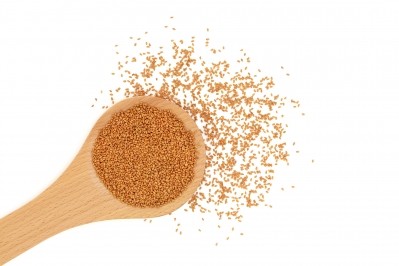GM crop omega-3 research offers hope for sustainable fish oil alternative

Omega-3 acids in oily fish - eicosapentaenoic acid (EPA) and docosahexaenoic acid (DHA) - are important components of cell membranes needed for normal development and cell function.
Several advisory bodies have made recommendations for intakes of EPA plus DHA ranging from 250-1000 mg/day in order to promote optimal health. However, consumption still remains low due to the limited, often expensive, and sometimes unpalatable, diet and supplement options.
What’s more, marine sources of EPA and DHA are diminishing in the face of increasing demand. Currently, marine sources can supply 0.2 million metric tons of EPA plus DHA; about 16% of the required global provision (Salem & Eggersdorfer 2015).
Despite increasing demands, most UK adults consume less than 50% of the amount of EPA plus DHA that is recommended to maintain health.
Now, funded by the Biotechnology and Biological Sciences Research Council (BBSRC) UK, a research team from Rothamsted Research Institute and the University of Southampton are researching an oil from GM Camelina sativa plant (one of Europe’s oldest oil seed crops) to test its suitability for replacement of oily fish in the human diet.
This development would not only ease the pressure on marine-derived supplies but also avoid the risk of consumption of heavy metals, dioxins and polychlorinated biphenyls (PCBs) that comes with fish consumption.
After identifying the potential for enhancing the plant’s seed oil composition around a decade ago, the team at Rothamsted have been growing and experimenting with the genetically modified version of the Camelina making EPA and DHA.
Recent studies from the team have revealed that this oil is well tolerated by humans and provides the same level of omega-3 fatty acids EPA and DHA as found in fish oil (12% and 9.5% respectively). What’s more, they’ve found it is as effective as fish oil at increasing blood and erythrocyte contents in humans, suggesting it may be able to confer the same health benefits.
Professor Johnathan Napier, omega-3 Camelina programme leader at Rothamsted, who also led the research, told NutraIngredients:”Having a land-based source of EPA and DHA means we no longer have to rely on marine harvests to provide these important fatty acids, helping to reduce pressure on fish stocks and the wider environment.
"Moreover, the power of agriculture means that far greater volumes of EPA and DHA can be produced than currently extracted from the oceans, ensuring optimal nutrition for all."
Project lead Graham Burge, Professor of Nutritional Biochemistry at the University of Southampton, adds: “These results are very exciting indeed - the potential opportunities for improving human nutrition and for UK agriculture this are huge.
“The pharmaceutical industry also has increasing demand for highly purified EPA and DHA for preparation of ethyl ester-based pharmaceutical products which currently incurs high production losses (90-95%) when these fatty acids are purified form fish oil (Kitessa et al. 2014).
“There is also great potential in the supplements industry, although that delivery method wouldn’t have the widest impact. In the first instance we are working towards bringing the health benefits of this oil widely available the general public.”
Funded by the BBSRC, the team will next collaborate with the University of Reading Food Sciences Department to work on options for fortifying everyday foodstuffs with the oil.
The study
Published in the British Journal of Nutrition, their recent blinded crossover study involved 31 healthy men and women (aged 20–74). The participants were randomised to consume 450 mg/d EPA þ DHA provided either as either CSO or FO for eight weeks, followed by six weeks washout and then switched to consuming the other test oil.
Fasting venous blood samples were collected at the start and end of each supplementation period. Resulting data revealed that consuming the test oils significantly (P < 0·05) increased EPA and DHA concentrations in plasma TAG, phosphatidylcholine and cholesteryl esters. What’s more, there were no significant differences between test oils in the increments of EPA and DHA.
Moreover, consuming either oil increased the Omega-3 index (Harris & Von Schacky 2004) by approximately 0.6 % points (West et al. 2020a).
However, the study was not powered to detect changes in these secondary outcomes and so the findings should be regarded as indicative of the potential for health benefits from consuming the transgenic C. sativa oil rather than as evidence of efficacy.
The blended fish oil and transgenic C. sativa oil were well tolerated in both trials with no adverse events that could be attributed to consuming either test oil. However, one participant withdrew from the dietary supplementation trial because they found the fish oil supplement unpalatable.
GM crops
Genetic insertion of desaturase and elongase enzymes from yeast and algae into plants that naturally produce ALA has facilitated the development of strains of canola (oilseed rape) and Camelina sativa (C. sativa) which produce oils that contain either EPA or DHA, or EPA plus DHA.
A transgenic strain of canola that produces an oil containing 10% DHA, but less than 1% EPA has been developed by the Commonwealth Scientific and Industrial Research Organisation (CSIRO) (Petrie et al. 2020) and commercialised by Nuseed (Tocher et al. 2019). Similarly, a transgenic strain of canola that produces a seed oil which contains 0.2% DHA and 8.1% EPA has been commercialised by Cargill for aquaculture feed (Napier et al. 2019).















